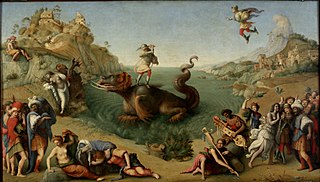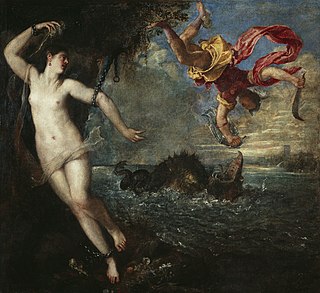Perseus Freeing Andromeda is the title of several paintings, including:
Perseus Freeing Andromeda is the title of several paintings, including:

In Greek mythology, Andromeda is the daughter of the king of Aethiopia, Cepheus, and his wife Cassiopeia. When Cassiopeia boasts that she is more beautiful than the Nereids, Poseidon sends the sea monster Cetus to ravage the coast of Aethiopia as divine punishment. Andromeda is chained to a rock as a sacrifice to sate the monster, but is saved from death by Perseus, who marries her and takes her to Greece to reign as his queen.
Perses may refer to:
In Greek mythology, Sthenelus was a name attributed to several different individuals:
Dictys was a name attributed to four men in Greek mythology.

Andromeda is one of the 48 constellations listed by the 2nd-century Greco-Roman astronomer Ptolemy, and one of the 88 modern constellations. Located north of the celestial equator, it is named for Andromeda, daughter of Cassiopeia, in the Greek myth, who was chained to a rock to be eaten by the sea monster Cetus. Andromeda is most prominent during autumn evenings in the Northern Hemisphere, along with several other constellations named for characters in the Perseus myth. Because of its northern declination, Andromeda is visible only north of 40° south latitude; for observers farther south, it lies below the horizon. It is one of the largest constellations, with an area of 722 square degrees. This is over 1,400 times the size of the full moon, 55% of the size of the largest constellation, Hydra, and over 10 times the size of the smallest constellation, Crux.

In Greek mythology, Perseus is the legendary founder of Mycenae and of the Perseid dynasty. He was, alongside Cadmus and Bellerophon, the greatest Greek hero and slayer of monsters before the days of Heracles. He beheaded the Gorgon Medusa for Polydectes and saved Andromeda from the sea monster Cetus. He was the son of Zeus and the mortal Danaë, as well as the half-brother and great-grandfather of Heracles.

Clash of the Titans is a 1981 fantasy adventure film directed by Desmond Davis and written by Beverley Cross which is loosely based on the Greek myth of Perseus. It stars Harry Hamlin, Judi Bowker, Burgess Meredith, Maggie Smith and Laurence Olivier. The film features the final work of stop motion visual effects artist Ray Harryhausen. It was released on June 12, 1981 and grossed $41 million at the North American box office, which made it the 11th-highest-grossing film of the year. A novelization of the film by Alan Dean Foster was published in 1981.

Andromeda is a lost tragedy written by Euripides, based on the myth of Andromeda and first produced in 412 BC, in a trilogy that also included Euripides' Helen. Andromeda may have been the first depiction on stage of a young man falling in love with a woman. The play has been lost; however, a number of fragments are extant. In addition, a number of ancient sources refer to the play, including several references in plays by Aristophanes.

Andromeda Chained to the Rocks (1630) is a 34 x 25 oil on panel painting by the Dutch Golden Age painter Rembrandt. It is now in the Mauritshuis, The Hague, Netherlands. Andromeda represents Rembrandt's first full length mythological female nude history painting and is taken from a story in Ovid's Metamorphoses.

Clash of the Titans is a 2010 action fantasy film and remake of the 1981 film of the same name produced by MGM. The story is very loosely based on the Greek myth of Perseus. An Australian-American production directed by Louis Leterrier and starring Sam Worthington, Gemma Arterton, Mads Mikkelsen, Alexa Davalos, Ralph Fiennes, and Liam Neeson, the film was originally set for standard release on March 26, 2010. However, it was later announced that the film would be converted to 3D and was released on April 2, 2010.

Perseus Freeing Andromeda is a painting by the Flemish artist Peter Paul Rubens, done in 1622. It is now in the Gemäldegalerie, Berlin, Germany.

Perseus with the Head of Medusa is a bronze sculpture made by Benvenuto Cellini in the period 1545–1554. The sculpture stands on a square base which has bronze relief panels depicting the story of Perseus and Andromeda, similar to a predella on an altarpiece. It is located in the Loggia dei Lanzi in the Piazza della Signoria in Florence, Italy. The second Florentine duke, Duke Cosimo I de' Medici, commissioned the work with specific political connections to the other sculptural works in the piazza. When the piece was revealed to the public on 27 April 1554, Michelangelo's David, Bandinelli's Hercules and Cacus, and Donatello's Judith and Holofernes were already installed in the piazza.

Perseus Freeing Andromeda or Liberation of Andromeda is a painting created by Piero di Cosimo, during the Italian Renaissance. The painting was praised by critics and art historians for its aesthetic, cosmological and political implications. The painting is a recreation of the myth of Perseus, the demi-god, who slays the sea monster and saves the beautiful Andromeda. The painting is based on a story created by the ancient Roman writer Ovid, in the Metamorphoses. The themes of the painting include platonic love, ideal beauty, marriage, and natural beauty. The painting includes portraits of the Medici family and many of Florentine's elite upper ruling class as characters in the story of Perseus Freeing Andromeda. The painting also represents a paragone between painting and sculpture. The painting resides in the Uffizi in Florence.

Wrath of the Titans is a 2012 action fantasy film and a sequel to the 2010 film Clash of the Titans. The film stars Sam Worthington, Rosamund Pike, Bill Nighy, Édgar Ramírez, Toby Kebbell, Danny Huston, Ralph Fiennes, and Liam Neeson, with Jonathan Liebesman directing a screenplay by Dan Mazeau and David Leslie Johnson. Wrath of the Titans takes place a decade after the events of the preceding film as the gods lose control over the imprisoned Titans and Perseus is called, this time to rescue his father Zeus, overthrow the Titans, and save mankind.

Perseus and Andromeda is a 1622 painting in the Hermitage Museum by the Flemish artist Peter Paul Rubens of the ancient Greek myth of Perseus and Andromeda after the former's defeat of the Gorgon. The composition is similar to that of an earlier painting by Rubens, Perseus frees Andromeda.

Perseus and Andromeda is an oil painting by Lord Frederic Leighton. Completed in 1891, the year it was displayed at the Royal Academy of Arts, it depicts the Greek mythological story of Andromeda. In contrast to the basis of a classical tale, Leighton used a Gothic style for the artwork. The painting is in the collection of National Museums Liverpool at the Walker Art Gallery.
Perseus and Andromeda is a story from Greek myth where Andromeda is saved by Perseus. Among many cultural depictions, it may refer to:

Perseus and Andromeda is a painting by the Italian Renaissance artist Titian, now in the Wallace Collection in London. It was painted in 1554–1556 as part of a series of mythological paintings called "poesie" ("poetry") intended for King Philip II of Spain. The paintings took subjects from the Roman poet Ovid's Metamorphoses, in this case Book IV, lines 663–752, and all featured female nudes.

Perseus Freeing Andromeda is a 1611 oil on canvas painter by the Dutch Mannerist painter Joachim Wtewael. Since 1982 it has been in the collection of the Louvre in Paris. A preparatory drawing for it also survives in the Albertina in Vienna, reprising the pose in the same artist's St Sebastian Bound to a Tree for Andromeda. In the final painting he used a less curving and more supple pose for Andromeda.
"Ah, lo previdi!” – “Ah, t’invola” – “Deh, non varcar", K. 272, is a concert aria by Wolfgang Amadeus Mozart for solo soprano and orchestra. One of Mozart's first large scale operatic concert pieces.